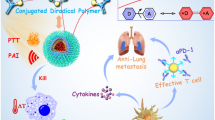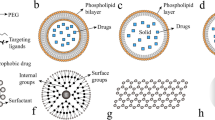Abstract
By integrating imaging and drug-delivery in a single system, fluorescent nano-multifunctional imaging platforms can offer simultaneous diagnosis and therapy to diseases like cancer. However, the synthesis of such system involves a tedious, time-consuming, and multi-step process. Herein we report a facile method based on simple ultrasonication to synthesize highly cross-linked, monodispersed fluorescent polyphosphazene nanoparticles from hexachlorocyclotriphosphazene (HCCP) and dichlorofluorescein (FD). Various functional groups (folic acid, PEG-NH2, and methylene blue) can be “fastened” in situ onto the poly(cyclotriphosphazene-co-dichlorofluorescein) (PCTPDF) nanoparticles to expand its application as nano-multifunctional platform. All the nanoparticles were characterized spectrophotometrically, and morphology was established by the images obtained from scanning electron microscope (SEM). The synthesized multifunctional nanoparticles exhibited low toxicity and penetrated through the cytomembranes of human colon cancer (HCT 116) cells. When applied to in vivo tumor imaging using biologically engineered mouse model, methylene blue functionalized (PCTPDF@MB) nanoparticles exhibited excellent photodynamic activity and imaging ability. Thus, PCTPDF nanoplatform based on multi-functional fluorescent nanoparticles might offer an efficient solution to new age theranostics. Apart from diagnostics application, PCTPDF, as a nanoplatform, could also be utilized to achieve more comprehensive application in modern analytic chemistry.

The table of contents









Similar content being viewed by others
References
Ozawa T, Yoshimura H, Kim SB. Advances in fluorescence and bioluminescence imaging. Anal Chem. 2013;85(2):590–609.
Jamwal HS, Chauhan GS (2016) Designing silica-based hybrid polymers and their application in the loading and release of fluorescein as a model drug and diagnostic agent. Adv Polym Tech n/a-n/a. p. 1–8.
Fuentes-Paniagua E, Serramía MJ, Sánchez-Nieves J, Álvarez S, Muñoz-Fernández MÁ, Gómez R, et al. Fluorescein labelled cationic carbosilane dendritic systems for biological studies. Eur Polym J. 2015;71:61–72.
Tsai HY, Li SY, Fuh CB. Magnetofluorescent nanocomposites and quantum dots used for optimal application in magnetic fluorescence-linked immunoassay. Anal Bioanal Chem. 2018;410(7):1–7.
Hayashi K, Sato Y, Sakamoto W, Yogo T. Theranostic nanoparticles for MRI-guided thermochemotherapy: “tight” clustering of magnetic nanoparticles boosts relaxivity and heat-generation power. ACS Biomater-Sci Eng. 2016;3(1):95–105.
Xiang LX, Gong H, Zhu WW, Wang C, Xu J, Feng LZ, et al. Antigen-loaded upconversion nanoparticles for dendritic cell stimulation, tracking, and vaccination in dendritic cell-based immunotherapy. ACS Nano. 2015;9(6):6401–11.
Zhou J, Liu Z, Li F. Upconversion nanophosphors for small-animal imaging. Chem Soc Rev. 2012;41(3):1323–49.
Gai S, Li C, Yang P, Lin J. Recent progress in rare earth micro/nanocrystals: soft chemical synthesis, luminescent properties, and biomedical applications. Chem Rev. 2014;114(4):2343–89.
Liu CJ, Zhang P, Zhai XY, Tian F, Li WC, Yang JH, et al. Nano-carrier for gene delivery and bioimaging based on carbon dots with PEI-passivation enhanced fluorescence. Biomaterials. 2012;33(13):3604–13.
Gu YP, Cui R, Zhang ZL, Xie ZX, Pang DW. Ultrasmall near-infrared Ag2Se quantum dots with tunable fluorescence for in vivo imaging. J Am Chem Soc. 2012;134(1):79–82.
Sun YP, Zhou B, Lin Y, Wang W, Fernando KA, Pathak P, et al. Quantum-sized carbon dots for bright and colorful photoluminescence. J Am Chem Soc. 2006;128(24):7756–7.
Guo Z, Park S, Yoon J, Shin I. Recent progress in the development of near-infrared fluorescent probes for bioimaging applications. Chem Soc Rev. 2014;43(1):16–29.
Montalti M, Prodi L, Rampazzo E, Zaccheroni N. Dye-doped silica nanoparticles as luminescent organized systems for nanomedicine. Chem Soc Rev. 2014;43(12):4243–68.
Wang X-D, Meier RJ, Wolfbeis OS. A fluorophore-doped polymer nanomaterial for referenced imaging of pH and temperature with sub-micrometer resolution. Adv Funct Mater. 2012;22(20):4202–7.
Jurado-Sanchez B, Escarpa A, Wang J. Lighting up micromotors with quantum dots for smart chemical sensing. Chem Commun (Camb). 2015;51(74):14088–91.
Jurado-Sanchez B, Pacheco M, Rojo J, Escarpa A. Magnetocatalytic graphene quantum dots Janus micromotors for bacterial endotoxin detection. Angew Chem. 2017;56(24):6957–61.
Wu Z, Esteban-Fernandez de Avila B, Martin A, Christianson C, Gao W, Thamphiwatana SK, et al. RBC micromotors carrying multiple cargos towards potential theranostic applications. Nanoscale. 2015;7(32):13680–6.
Liang Y, Lin S, Liu L, Hu J, Cui W. Oil-in-water self-assembled Ag@AgCl QDs sensitized Bi2WO6: enhanced photocatalytic degradation under visible light irradiation. Appl Catal B – Environ. 2015;164:192–203.
Tissandier C, Diop N, Martini M, Roux S, Tillement O, Hamaide T. One-pot synthesis of hybrid multifunctional silica nanoparticles with tunable coating by click chemistry in reverse w/o microemulsion. Langmuir. 2012;28(1):209–18.
Zhang XY, Zhang XQ, Yang B, Hui JF, Liu MY, Liu WY, et al. PEGylation and cell imaging applications of AIE based fluorescent organic nanoparticles via ring-opening reaction. Polym Chem. 2014;5(3):689–93.
Zeng H, Zhang D, Zhai X, Wang S, Liu Q. Enhancing the immunofluorescent sensitivity for detection of acidovoraxcitrulli using fluorescein isothiocyanate labeled antigen and antibody. Anal Bioanal Chem. 2018;410(1):71–7.
Song ZG, Kwok RT, Zhao EG, He ZK, Hong YN, Lam JW, et al. A ratiometric fluorescent probe based on ESIPT and AIE processes for alkaline phosphatase activity assay and visualization in living cells. ACS Appl Mater Interface. 2014;6(19):17245–54.
Wang YH, Jiang CN, Wen GQ, Zhang XH, Luo YH, Qin AM, et al. A sensitive fluorescence method for detection of E. coli using rhodamine 6G dyeing. Luminescence. 2016;31(4):972–7.
Liu MY, Ji JZ, Zhang XY, Zhang XQ, Yang B, Deng FJ, et al. Self-polymerization of dopamine and polyethyleneimine: novel fluorescent organic nanoprobes for biological imaging applications. J Mater Chem. 2015;3(17):3476–82.
Hong Y, Lam JWY, Tang BZ. Aggregation-induced emission. Chem Soc Rev. 2011;40(11):5388.
Luo JD, Xie ZL, JWY L, Cheng L, Chen HY, Qiu CF, et al. Aggregation-induced emission of 1-methyl-1,2,3,4,5-pentaphenylsilole. Chem Commun. 2001;18(18):1740–1.
Possel H, Noack H, Augustin W, Keilhoff G, Wolf G. 2,7-Dihydrodichlorofluorescein diacetate as a fluorescent marker for peroxynitrite formation. FEBS Lett. 1997;416(2):175–8.
Sun LJ, Liu TH, Li H, Yang L, Meng LJ, Lu QH, et al. Fluorescent and cross-linked organic-inorganic hybrid nanoshells for monitoring drug delivery. ACS Appl Mater Interface. 2015;7(8):4990–7.
Zhu L, Zhu Y, Pan Y, Huang Y, Huang X, Tang X. Fully cross-linked poly[cyclotriphosphazene-co-(4,4′-sulfonyldiphenol)] microspheres via precipitation polymerization and their superior thermal properties. Macromol React Eng. 2007;1(1):45–52.
Greish YE, Bender JD, Lakshmi S, Brown PW, Allcock HR, Laurencin CT. Low temperature formation of hydroxyapatite-poly(alkyl oxybenzoate)phosphazene composites for biomedical applications. Biomaterials. 2005;26(1):1–9.
Orme CJ, Stewart FF. Mixed gas hydrogen sulfide permeability and separation using supported polyphosphazene membranes. J Membrane Sci. 2005;253(1/2):243–9.
Wen P, Tai Q, Hu Y, Yuen RKK. Cyclotriphosphazene-based intumescent flame retardant against the combustible polypropylene. Ind Eng Chem Res. 2016;55(29):8018–24.
Li X, Chen L. Fluorescence probe based on an amino-functionalized fluorescent magnetic nanocomposite for detection of folic acid in serum. ACS Appl Mater Interface. 2016;8(46):31832–40.
Luangtana-anan M, Nunthanid J, Limmatvapirat S. Effect of molecular weight and concentration of polyethylene glycol on physicochemical properties and stability of shellac film. J Agri Food Chem. 2010;58(24):12934–40.
Matsumura S, Sato S, Yudasaka M, Tomida A, Tsuruo T, Iijima S, et al. Prevention of carbon nanohorn agglomeration using a conjugate composed of comb-shaped polyethylene glycol and a peptide aptamer. Mol Pharm. 2009;6(2):441–7.
Yu J, Hsu CH, Huang CC, Chang PY. Development of therapeutic Au-methylene blue nanoparticles for targeted photodynamic therapy of cervical cancer cells. ACS Appl Mater Interface. 2015;7(1):432–41.
Acknowledgements
This work was supported by the National Natural Science Foundation of China (61335012).
Author information
Authors and Affiliations
Corresponding author
Ethics declarations
All animal experiments were approved by the Institutional Animal Care and Use Committee of Xi'an Jiaotong University and were performed according to the institution's guidelines for the use of laboratory animals.
Conflict of interest
The authors declare that they have no conflict of interest.
Electronic supplementary material
ESM 1
(PDF 1946 kb)
Rights and permissions
About this article
Cite this article
Wang, Z., Hu, M., Hu, S. et al. Facile one-pot synthesis of multifunctional polyphosphazene nanoparticles as multifunctional platform for tumor imaging. Anal Bioanal Chem 410, 3723–3730 (2018). https://doi.org/10.1007/s00216-018-1035-5
Received:
Revised:
Accepted:
Published:
Issue Date:
DOI: https://doi.org/10.1007/s00216-018-1035-5




